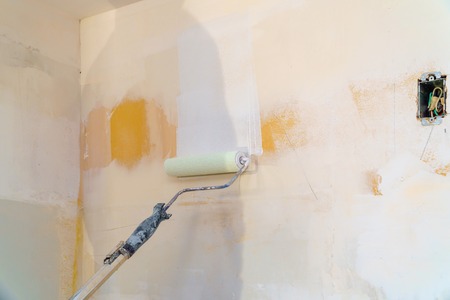Introduction: Setting the Tone for Your Space
When it comes to making your house feel like a home, the way you finish your walls is a game changer. In the American real estate market, first impressions matter, and both wallpaper and paint offer distinct ways to showcase your style while boosting your property’s appeal. Whether you’re aiming to sell at a premium or simply want to create a space that reflects your personality, the choice between wallpaper and paint is more than just cosmetic—it can directly impact your home’s value and livability. Understanding the pros and cons of each option helps ensure your investment pays off, both in daily enjoyment and future returns. In this article, we’ll break down everything you need to know about wallpaper versus paint so you can make an informed decision that fits your lifestyle and maximizes your space’s potential.
2. Wallpaper: Pros, Cons, and Where It Shines
When it comes to transforming a room with personality and flair, wallpaper stands out as a popular choice among American homeowners looking to make a bold design statement. Lets break down the key pros and cons of using wallpaper, so you can see if this investment is right for your space.
Advantages of Wallpaper
- Style Variety: From classic florals to modern geometrics, wallpaper offers endless patterns, textures, and colors. If youre after something unique or want to make a room pop, wallpaper gives you options paint simply cant match.
- Durability: High-quality wallpapers are built to last 10–15 years or more. Theyre especially resistant to scratches and marks in high-traffic areas like hallways or family rooms.
- Instant Visual Impact: With the right design, wallpaper can create dramatic accent walls or add depth to small spaces—great for boosting property appeal if you’re thinking about resale value.
Drawbacks of Wallpaper
- Upfront Cost: Wallpaper is generally more expensive than paint, both in material and installation costs. Skilled labor might be necessary for complex patterns or textured papers.
- Difficult Removal: When trends change or your taste evolves, removing old wallpaper can be time-consuming and may require special tools or chemicals.
- Sensitive to Moisture: Standard wallpaper isn’t ideal for bathrooms or kitchens unless you choose moisture-resistant varieties designed for those environments.
Cost Comparison: Wallpaper vs. Paint
| Wallpaper | Paint | |
|---|---|---|
| Material Cost (per sq ft) | $1.50–$6+ | $0.50–$3 |
| Labor Cost (per sq ft) | $1–$4 | $0.50–$2 |
| Lifespan | 10–15 years | 5–10 years |
| Total Investment (Avg Room) | $400–$1200+ | $200–$600+ |
Where Wallpaper Works Best
- Accent Walls: Add character and visual focus without overwhelming a room.
- Entryways & Hallways: Durable enough to withstand heavy use while offering immediate curb appeal for guests or potential buyers.
- Bedrooms & Dining Rooms: Ideal for creating cozy vibes or sophisticated dining experiences with rich textures or luxe finishes.
Investment Takeaway
If youre looking to boost your homes wow factor and dont mind spending a bit more upfront for long-term durability and style, wallpaper is a smart bet—especially in spaces where you want maximum impact with minimum maintenance. Just remember: its best suited for dry areas and requires thoughtful planning if resale value is your goal.
![]()
3. Paint: Benefits, Drawbacks, and Popular Uses
When it comes to revamping your walls, paint offers unmatched flexibility and a straightforward approach that appeals to American homeowners seeking fast results and maximum customization. Let’s break down what makes paint such a popular choice, where it shines in your home, and what you should watch out for before picking up that roller.
Benefits of Paint: Flexibility Meets Affordability
One of the biggest perks of using paint is its versatility. Whether you want a bold accent wall or a subtle backdrop, there’s a color and finish for every mood and design goal. Paint allows you to switch up your style as trends change—at a fraction of the cost of wallpaper. Plus, if you’re prepping your home for sale or rental, freshly painted walls can deliver immediate curb appeal and boost perceived value with minimal investment.
Quick Fixes & Easy Updates
Paint is perfect for quick makeovers. Got scuffs or minor wall damage? A touch-up can make your space look new again. This makes paint an ideal solution for high-traffic areas like hallways, kids’ rooms, or entryways where wear-and-tear is inevitable.
Low Maintenance & Repairability
Unlike wallpaper, which can peel or stain permanently, paint is generally easier to clean and repair. Most modern paints are washable, meaning crayon marks or fingerprints aren’t permanent disasters. For real estate investors or busy families, this translates to less hassle and lower long-term maintenance costs.
Drawbacks of Paint: Considerations Before You Commit
No product is perfect—paint included. While it offers flexibility, painted walls can be prone to chipping or fading over time, especially in sunny rooms or spaces with lots of moisture like bathrooms. Deep colors may require multiple coats and more prep work. And while painting is usually DIY-friendly, achieving professional-looking results takes patience and skill.
Where Paint Works Best in Your Home
Paint shines in living rooms, bedrooms, kitchens, offices—basically any area where you want control over color and finish without a long-term commitment. In open-plan homes common across the U.S., coordinated paint colors can help define spaces while keeping the overall vibe cohesive. For bathrooms and kitchens, opt for moisture-resistant paints designed to withstand steam and splashes.
The Investment Angle
If you’re weighing ROI, remember that neutral paint colors have broad market appeal when selling or renting a property. Painting is one of the most cost-effective updates you can make before listing a home—sometimes yielding returns well above the initial investment by attracting buyers who want move-in ready spaces.
4. Style & Trends: What’s Hot in the U.S. Right Now
When it comes to home interiors, Americans are all about making a statement while maximizing return on investment (ROI). The debate between wallpaper and paint isn’t just about aesthetics—it’s about what’s trending, what adds value, and how you can stand out in today’s real estate market.
Wallpaper Trends: Bold is Back
In 2024, U.S. homeowners are gravitating toward bold wallpapers—think oversized florals, geometric patterns, and textured finishes. Peel-and-stick wallpapers are especially popular for their DIY appeal and easy removal, making them perfect for renters or anyone who likes to switch things up regularly. Accent walls with dramatic wallpaper can turn a basic room into a showstopper, which appeals to buyers seeking unique spaces.
Paint Trends: Neutral with a Pop
Paint remains king for its versatility and resale value. The most popular shades across American homes include warm whites, greige (gray-beige), and soft earth tones. However, savvy homeowners are adding pops of color—like navy blue doors or olive green cabinets—to create focal points without overwhelming the space. These subtle updates can significantly boost curb appeal and perceived value.
Design Choices & ROI: What’s Worth Your Money?
| Option | Trend Factor | Ease of Change | ROI Potential |
|---|---|---|---|
| Wallpaper (Accent Wall) | High – Statement-Making | Moderate – Peel-and-Stick is Easy | Good – Adds Wow Factor |
| Wallpaper (Full Room) | Medium – Risk of Overwhelm | Low – Harder to Remove | Variable – Can Be Polarizing |
| Paint (Neutral Shades) | Timeless – Always In Demand | Easy – Quick Updates Possible | Excellent – Broad Appeal |
| Paint (Bold Colors) | Trendy – Adds Personality | Easy – Paint Over as Needed | Good – If Used Sparingly |
Pro Tips for Boosting Home Value:
- Create contrast: Use neutral paint throughout the main spaces, then add one wallpapered accent wall in the living room or bedroom for instant impact.
- Avoid overdoing trends: Go bold in small doses—buyers love personality but prefer flexibility.
- Select high-quality materials: Whether you choose paint or wallpaper, opt for durable finishes that withstand daily wear and tear.
- Add texture: Grasscloth wallpapers or matte paints add depth and elevate the feel of any room.
- Cater to local style: Research what’s popular in your area—suburban buyers may favor neutrals, while urban markets embrace eclectic looks.
The bottom line: In the U.S., both wallpaper and paint can make your space shine if you play to current trends and think strategically about long-term value. Choose wisely based on your goals—whether that’s resale, rental income, or simply creating a home that reflects your personality.
5. Investment & ROI: Which Option Adds More Value?
When it comes to home improvements, American homeowners are always thinking about how each decision affects their propertys value and future resale potential. Lets break down the investment returns of wallpaper versus paint, so you can make a choice that’s not just stylish, but financially smart.
Wallpaper: Style Statement or Risky Bet?
Wallpaper can instantly elevate the look of a room, making spaces feel unique and high-end. This wow factor may appeal to some buyers, especially in trend-forward markets or luxury homes. However, wallpaper is a personal design choice—what you love might be a dealbreaker for potential buyers. Removing or replacing wallpaper before selling can be labor-intensive and costly, which could actually hurt your home’s marketability if your choices are too bold or dated.
ROI Insights:
- Initial installation is more expensive than paint
- May increase perceived value in niche markets
- Could limit buyer pool due to taste preferences
Paint: Safe Bet with Broad Appeal
Freshly painted walls in neutral tones are widely recommended by U.S. realtors for good reason—they provide a clean canvas that helps buyers envision themselves in the space. Paint is affordable, easy to update, and appeals to most tastes. A well-executed paint job can offer one of the highest returns on investment for pre-sale prep, often recouping several times its cost at closing.
ROI Insights:
- Lower upfront costs and higher flexibility
- Strong positive impact on resale value
- Makes homes feel move-in ready
Long-Term Perspective: Maintenance & Durability
If you plan to stay in your home long-term, consider durability and upkeep. High-quality wallpaper can last up to 15 years without fading or chipping, potentially saving money over time compared to repainting every few years. However, if trends change or damage occurs, updating paint is far easier and cheaper than removing wallpaper.
The Bottom Line
If maximizing ROI and broad market appeal are your top priorities—especially if youre prepping for sale—paint is typically the smarter investment. But if youre creating a personalized dream home where you’ll stay for years, thoughtfully chosen wallpaper could boost both enjoyment and value in the right context.
6. Practical Considerations: DIY, Maintenance, and Longevity
Cost Breakdown: Initial Investment vs. Long-Term Value
When deciding between wallpaper and paint, your budget plays a huge role—not just the upfront costs, but also what youll spend over time. Paint is generally more affordable on the front end. A gallon of quality interior paint in the U.S. runs about $30–$60, and most rooms require 1-2 gallons plus basic supplies. Wallpaper, on the other hand, can cost anywhere from $25 to $100+ per roll, with most rooms needing several rolls. Add in adhesive and specialty tools, and you’re looking at a steeper initial investment. However, wallpaper tends to last longer—up to 15 years if properly installed—while painted walls usually need a refresh every 5-7 years.
Time & Skill: DIY or Hire a Pro?
If you’re handy and looking to save cash, both painting and wallpapering are doable as DIY projects—but they come with different challenges. Painting is more beginner-friendly; most Americans have at least some experience painting walls, and YouTube is packed with tutorials. You can usually knock out an average-sized room in a weekend.
Wallpaper demands more precision. Lining up patterns and smoothing out air bubbles takes patience and skill—if you rush it, mistakes are costly and noticeable. If youre going for textured or high-end paper, hiring a professional installer is often worth it to avoid headaches down the road.
Maintenance & Repairs
Painted walls are easy to clean (just use mild soap and water), and touch-ups blend well if you keep extra paint on hand. Scratches, scuffs, or even crayon marks from kids? No big deal—just repaint the affected area.
Wallpaper requires gentler cleaning; too much scrubbing can damage the finish or lift edges. Repairs are trickier—patching damaged sections without it being obvious can be tough unless you have leftover rolls from the original batch.
Longevity: How Do They Hold Up?
Paint is vulnerable to chips, fading (especially in sunny rooms), and moisture if not sealed correctly. High-traffic areas may need frequent touch-ups. Wallpaper stands up better in terms of wear-and-tear but can peel or bubble in humid spaces like bathrooms unless you choose specialty options designed for moisture resistance.
From an investment perspective: If you want a quick refresh or enjoy changing your décor every few years, paint is flexible and forgiving. For those seeking durability with bold style—and who don’t mind a higher upfront cost—wallpaper offers serious staying power.
7. Making the Choice: Which Is Best for Your Space?
When it comes down to choosing between wallpaper and paint, the answer really depends on your lifestyle, budget, and long-term plans for your home. Here’s a practical checklist to guide your decision:
Consider Your Lifestyle
If you have kids or pets, durability and cleanability are key. Paint—especially high-quality satin or semi-gloss finishes—can be wiped down easily and touched up with minimal hassle. However, modern vinyl wallpapers are also designed to be scrubbable and tough, making them a viable option in high-traffic areas.
Weigh Your Budget
If you’re renovating on a tight budget, paint is usually less expensive upfront, both in material and labor costs. But don’t overlook the long-term value: quality wallpaper can last 10-15 years without fading or chipping, potentially saving money on frequent repaints. For those seeking designer looks on a budget, consider using wallpaper as an accent wall rather than covering an entire room.
Think About Your Future Plans
If you plan to move soon or like changing your décor often, paint offers maximum flexibility. On the other hand, if you’re settling in for the long haul and want a unique statement look, investing in wallpaper could pay off in satisfaction and resale appeal.
Expert Tip: Combine Both for the Best of Both Worlds
You don’t have to choose just one! Interior designers often blend painted walls with wallpapered accent spaces for visual interest and balance. Try painting three walls a versatile color and adding wallpaper behind a bed, in a powder room, or on a ceiling for dramatic effect.
Action Steps for Your Decision
- Assess each room’s function (high-traffic vs. low-traffic)
- Set your budget and get quotes for both options
- Test paint swatches and order wallpaper samples at home
- Factor in time and maintenance—are you ready for DIY or hiring pros?
Ultimately, the “best” choice is personal. Use these criteria to make an investment that fits your lifestyle now—and adds value if you sell later. Whether you go bold with wallpaper or classic with paint (or mix both), let your space reflect your taste and needs.


